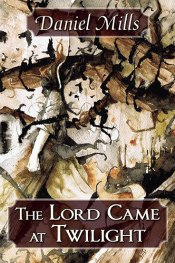 In reading through the fourteen tales which comprise this remarkable debut, I could not help but wonder about the author’s method in creating them. Did his preparation include nineteenth-century garb, a pair of infinity-shaped eyeglasses, a dark chamber excluding all but antiquated desk, candle and quill? I share this fantastic premise simply because I am at a loss as to how Daniel Mills so perfectly taps into the era of which he writes. There is an effortless magic to both his prose and imagination, a magic which quite literally sweeps the reader out of their known world.
In reading through the fourteen tales which comprise this remarkable debut, I could not help but wonder about the author’s method in creating them. Did his preparation include nineteenth-century garb, a pair of infinity-shaped eyeglasses, a dark chamber excluding all but antiquated desk, candle and quill? I share this fantastic premise simply because I am at a loss as to how Daniel Mills so perfectly taps into the era of which he writes. There is an effortless magic to both his prose and imagination, a magic which quite literally sweeps the reader out of their known world.
In his illuminating introduction to The Lord Came at Twilight, Simon Strantzas rightly includes Mills with a cadre of contemporary authors who have the ability to “re-contextualize what’s come before in new and exciting ways.” This is nowhere more evident than in “Dust From a Dark Flower”, which reads like an exquisite cross between the tales of Nathaniel Hawthorne and John Carpenter’s The Thing. Personally, I found Mills’ creation more terrifying.
“MS Found in a Chicago Hotel Room”, which jumps up the time-stream only slightly to 1893, is one of the finest (and most imaginative) renderings of a “King in Yellow” story that I have ever read, not only in its seedy and convincingly-sketched backdrop but in its use of a very unique first-person protagonist—a certain gentleman who I simply cannot reveal for fear of spoiling the denouement.
Fans of H.P. Lovecraft (and I include myself here) will rejoice in “Whisperers”, which features two familiar characters from the old gent’s oeuvre—namely Randolph Carter and Henry Ackley. This is one of the few tales that ventures into twentieth-century territory. Indeed, the introduction of a Ford truck in the opening scene comes as a bit of a shock after acclimating oneself to the horse-and-buggy milieu of the previous century.
“House of the Caryatids” is a carefully-wrought tale which brings to mind the Civil War fiction of Ambrose Bierce (I’m thinking here of “An Occurrence at Owl Creek Bridge”), as well as Arthur Machen’s “The Great God Pan”. The story involves three soldiers who stray from the battlefields of Shiloh, only to encounter stranger horrors when they stumble upon a seemingly derelict old manse in the woods.
“The Naked Goddess” features an elderly narrator recalling his experience as a young man in a secluded town made up entirely of blind residents. It is only at the very end of the tale (in the form of a historical pamphlet) that we learn of the diabolic cause of this oddity. While most of the stories in this collection are accompanied by illustrations, I found the one complimenting this to be the most haunting and effective.
Daniel Mills strikes me as writer who thrills at the idea of imagining the past, someone who will stop at the side of the road to admire a lonely field, derelict house, leaning barn or crumbling chimney. He understands the dark mysteries such structures hold and is only too willing to listen to the ghosts of the past. The Lord Came at Twilight is an important and original book in the field of weird fiction, belonging in all enthusiasts’ libraries.
Available for purchase from Dark Renaissance Books.